Your Complete Guide to Toilet Flanges
Today’s market offers a variety of flange types based on material composition. Among some of the options are plastics (PVC, ABS), cast iron, brass or materials based on specific application needs.
Ultimately, the choice of toilet flange depends on the material of the DWV pipe it is being connected to. It’s helpful to know the different types, sizes and features when you need to repair or replace a damaged flange. But before we jump into the various options, let’s first discuss the function of a toilet flange.
What is a toilet flange?
A toilet flange, also called a closet flange, is a pipe fitting that connects a toilet to the drainage system while also securing it to the finished floor. A toilet flange securely attaches a toilet to the home’s drainage system through an approved connection method. The flange is also anchored to the subfloor with a rust-proof screw keeping it stable and free from movement.
A wax ring mounted on the closet flange creates a watertight seal between the bottom of the toilet and the closet flange, preventing any leaks, odors or sewer gases from escaping the fixture. T bolts, or as Oatey calls them, "Johni-Bolts," are used to connect the toilet (via slots) to the toilet flange.
How to choose the right toilet flange
As mentioned earlier, keep in mind that the choice of toilet flange depends on the material of the pipe (the drainage or sanitary system) and connection method.
That means if you have a PVC pipe connection, you should install a PVC closet flange. A cast iron connection will require a cast iron toilet flange, and so forth.
Before you head to your local supply house or nearest hardware store to purchase a toilet flange, let’s explore the different types to ensure you choose the correct toilet flange for your particular application.
Types of flanges
1. PVC or ABS Toilet Flanges
The Oatey® Level Fit Closet Flange is a good choice when you are simply changing out the flange. The PVC toilet flange (or ABS) quickly and easily connects water closet outlets to a plumbing system and sits flush on the finished floor surface.
The test cap is designed to break out cleanly and easily, eliminating the possibility of falling down the drain. The Level Fit is available with a stainless steel, metal, or plastic ring. It can be installed inside 3" Schedule 40 DWV or over 3" Schedule 40 DWV pipe, inside 4" Schedule 40 DWV pipe or over 4" Schedule 40 DWV pipe. The advantage of an inside pipe toilet flange is that you don’t have to worry about concrete surrounding the pipe, especially in commercial or basement applications where a concrete pour usually happens before the toilet installation.
Watch this video to learn how to install a toilet flange like Level Fit.
Oatey® Easy Tap® Closet Flanges are a good choice for PVC or ABS applications. They are available in various materials and styles, with a test cap that easily and cleanly breaks out, also eliminating the possibility of falling down the drain. Available with a stainless steel, metal, or plastic ring, Oatey Easy Tap fits over 3" pipe or inside 4” pipe.
The use of a closet flange with a knockout plug will depend on the application. So, if you are installing a new plumbing system that requires testing or remodeling a bathroom and would like to keep sewer gases from escaping, Easy Tap is a good option.
Oatey has another flange similar to Easy Tap called Fast Set. The only difference is that Fast Set comes with or without a test cap.
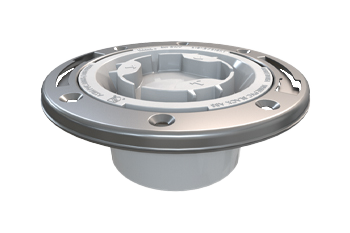
2. Cast Iron Toilet Flanges
Oatey® Cast Iron Closet Flanges are designed for use on plastic pipe or heavyweight, service weight or no-hub cast iron soil pipe. The installation does not require caulking, and it comes complete with the body, brass ring, bolts, and gasket. These flanges install on the outside of either 3" or 4" pipe and can be used without needing access from below.
To install an Oatey Cast Iron Closet Flange:
- Place it over the pipe so the gasket secures to the pipe.
- Tighten the integrated fasteners to the pipe to secure the closet flange.
- Use fasteners to secure the flange to the subfloor, and then add the closet bolts to secure the toilet fixture.
Oatey also has a Cast Iron Deepset Closet Flange, which has all the same features as an Oatey® Cast Iron Closet Flange but with a 4" deep-set barrel. The deep-set feature comes in handy if the pipe happens to be lower or if the floor is raised.
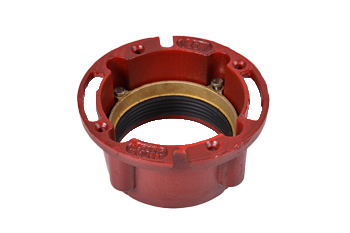
3. Brass Toilet Flange Ring
Some older homes may still have a lead bend in place, relying on the use of a brass closet flange. This connection should be performed by a skilled tradesperson because it requires a more traditional connection method.
When the connection is made, the lead is peened to the inside of the closet flange and the two materials are joined together with solder. Most of the time, when repairing a brass flange, the lead material may have deteriorated beyond repair. If this is the case, the old lead bend will have to be replaced.
The Oatey® 3" or 4" Brass Closet Flange Replacement Ring is available for brass applications. The Brass Closet Flange Replacement Ring Easily installs by inserting the ring onto the lead bend after the old flange is removed. It has three countersunk holes and three closet bolt slots for a secure attachment to the floor.
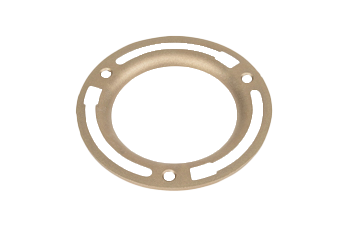
4. Specialty Options
- 45-Degree Closet Flanges: The Oatey® ABS or PVC 45-Degree Closet Flange with Plastic or Stainless Steel Ring is designed for applications in which clearance doesn't allow for normal flange installation.
- With a 45-Degree Closet Flange the hub comes off the bottom of the closet flange at a 45-degree angle. This is helpful if there is an obstruction underneath or if you need clearance where an application doesn't allow direct attachment vertically into the closet flange. The 3" or 4" Level Fit 4- Degree Closet Flange allows for solvent welds over 3" or inside 4" Schedule 40 DWV pipe.
- The choice between metal versus plastic rings is based on personal preference, but an advantage of a metal ring is that it provides adjustability with a 360-degree swivel. Some installers prefer a plastic ring because they feel it will not corrode, but remember that a plastic ring is more likely to break if you over-tighten it. Oatey’s stainless steel ring is corrosion-resistant.
- Offset Closet Flanges: Used for PVC or ABS applications, the Oatey® Level Fit Offset Closet Flange can be rotated for precise alignment of bolts and screws. The rings provide flexibility with a 360-degree swivel.
- So if there are floor joists that prevent the closest flange from being centered during installation, the Level Fit Offset Closet Flange offsets the hub of the closet flange around that obstacle. That way, you can still install the toilet where it needs to go. This flange is available with a stainless steel/metal ring that provides added strength and cracking resistance to the flange and can be rotated to allow precise alignment of bolts and screws.
- Oatey® Fast Set™ Spigot Fit Closet Flange, also known as a street fitting, is “same as pipe size,” meaning the same as the end of a piece of PVC/ABS pipe and used in the hub-end of a fitting. The flange can be cemented right into the hub. A street fitting can be used in a situation where the waste pipe is close to where the finished floor is already.
- Say, for example, you don't have a lot of room, and there is a 90-degree hub close by. But you don't want to install pipe in it because it is so close. You can then use the Fast Set™ Spigot Fit Closet Flange and cement it right into that hub.
- The Fast Set™ Spigot Fit Closet Flange includes eight countersunk holes and two toilet bolt slots for secure attachment to the floor.
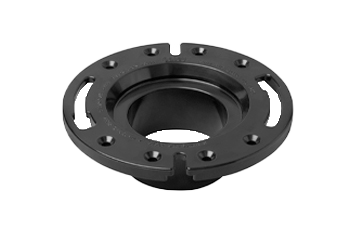
Toilet Flange Repair Kits & Options
Oatey offers a range of toilet flange accessories and quick-repair options. Below, we share some options that will make it easier to complete certain flange repair or replacement applications.
- Replace a broken cast iron or PVC/ABS flange
- The Oatey® Twist-N-Set® Replacement Closet Flange is a good option for broken cast iron flanges needing replacement. The Twist-N-Set Replacement Closet Flange is designed to replace broken cast iron closet flanges with a gasket that expands to fit inside heavyweight, service weight, and no-hub pipe. Twist-N-Set can also be used on PVC or ABS pipe.
- Repair a broken toilet flange
- The Oatey® Fix-it Repair Ring is a great option when you have a damaged flange, but the damage is not bad enough to warrant replacing the entire flange.
- The Fix-it Repair Ring securely repairs broken, cracked or worn-out toilet-mounting flanges without replacing the toilet flange. The universal design fits all flange and toilet installations and works with a wide range of flooring types, including concrete. The mounting tabs fit all toilet styles and accommodate 1/4" or 5/16" closet bolts.
- This ring makes repairs easy because it can be installed above the broken flange with four screws and silicone sealant. No solvent cementing or special tools are required, making it ideal for the average homeowner.
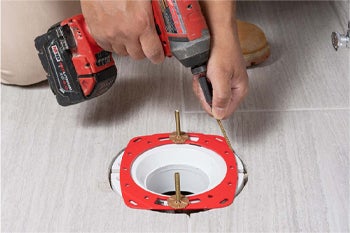
Note: Inspect the toilet flange for cracks or decay. If the drain section of the flange is damaged or so rusted out that it can no longer hold the bolts that secure the toilet, complete replacement is necessary.
Watch this video to learn how to repair a broken toilet flange using the Fix-it Repair Ring.
- Correct flange elevations
- Best practices call for a toilet flange to be installed flush with or atop the finished floor. Placing it beneath a tile floor will cause drainage issues — especially leaks. In addition, a toilet flange sitting below the tile will create instability for the user over time. Toilet flanges are essential in securing the toilet to the floor; if compromised, rocking and leaks will soon result in ruining a newly renovated bathroom.
- The Oatey Set-Rite® Toilet Flange Extension Kit is a UPC-listed, watertight solution for raising the toilet flange during a remodel. Oatey Set-Rite Toilet Flange Extension Kits allow users to easily extend the toilet flange surface above the finished floor for optimum sealing with a standard wax ring. The kits can be used on existing PVC, ABS, cast iron, and stainless steel flange rings. Spacers can also be combined to meet the desired height, while a foam rubber gasket seals the spacers to the new flange.
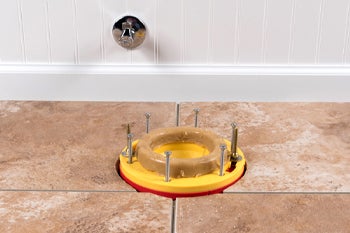
Able to correct flange elevations ranging from 1/4" to 1-5/8" using various spacer sizes, the kit includes four different spacers and six self-tapping screws to complete the installation.
Watch this video to learn how to replace a toilet flange with Set-Rite® Extension Kits.
Now that we have explored the different types of toilet flanges, you can choose the correct toilet flange for your particular application.
Not sure how to repair a toilet flange? Check out our project guide for step-by-step instructions on how to replace, repair and re-attach your toilet.